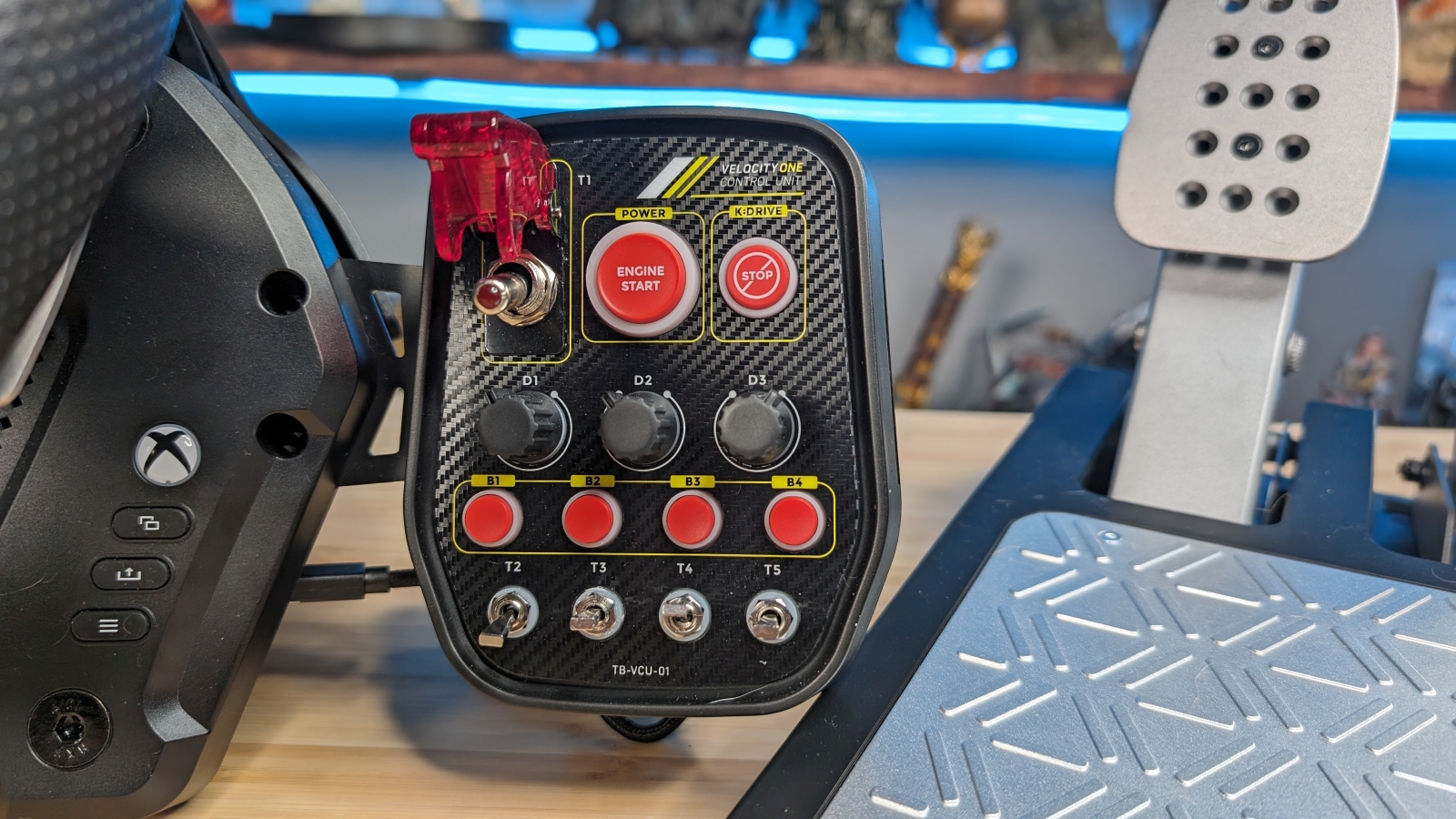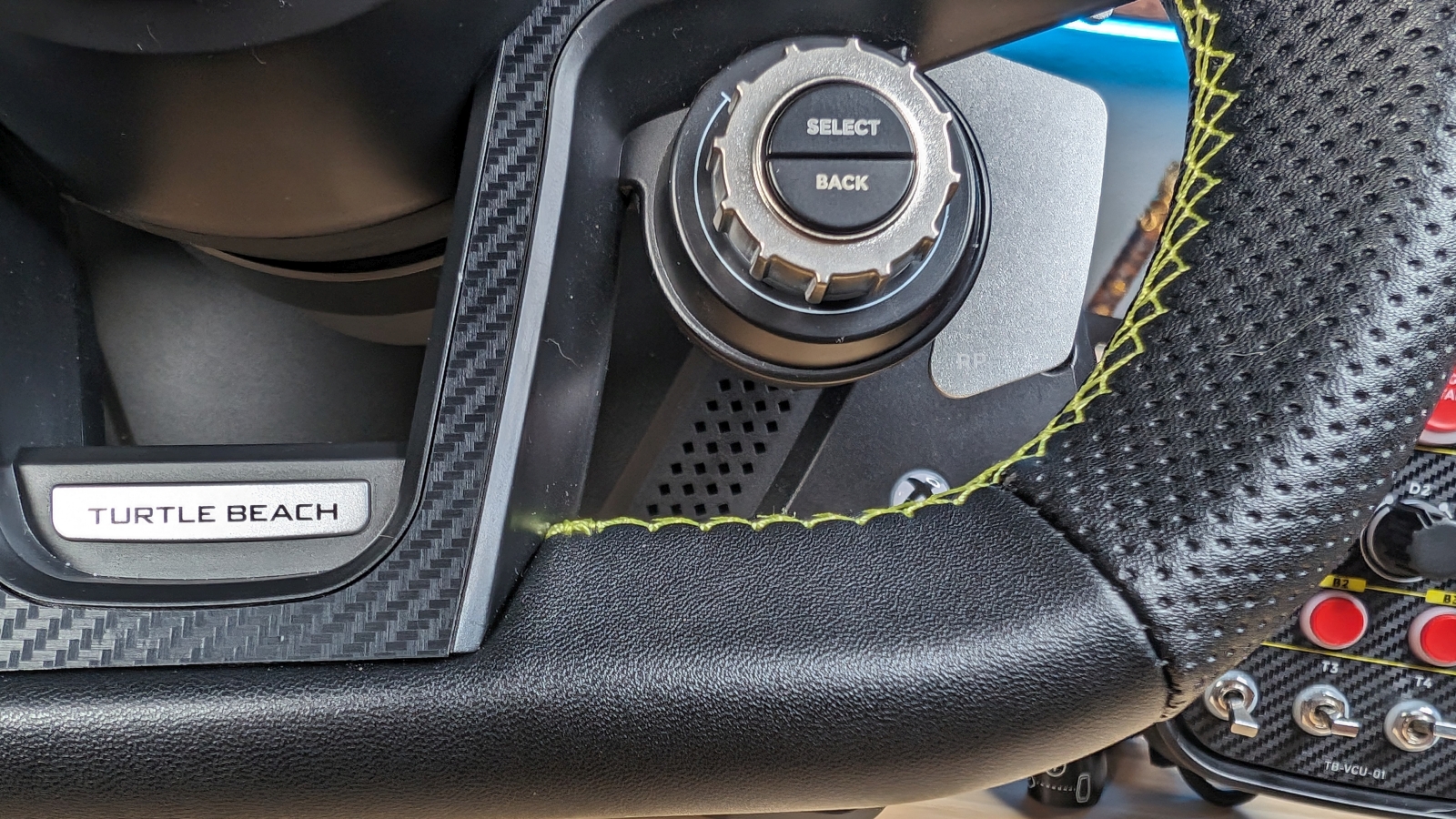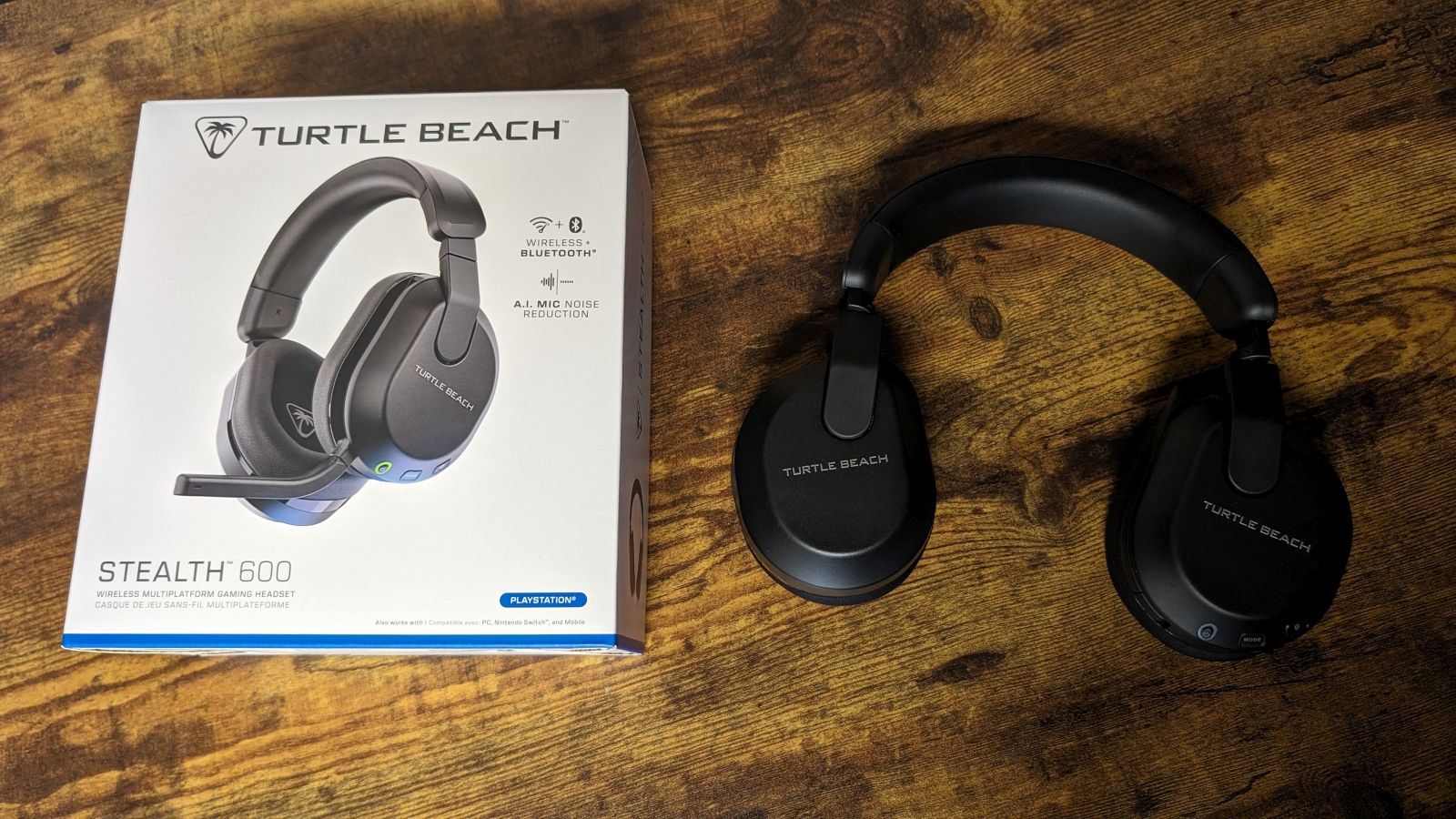I’m old enough to remember when force feedback was mostly vibration and the occasional kick in one direction or another. Microsoft made mech combat better with a force feedback joystick called the Sidewinder Force Feedback Pro, and then followed with a racing wheel, the Sidewinder Force Feedback Wheel, both launching in 1997. Logitech gave us a new way to race with the Wingman Formula Force. A handful of other wheels and sticks popped into the market, but then they just…stopped. Sure, some speciality teams continued to make force feedback accessories, but for a long time it fell out of fashion. Every once in a while you’d see a product pop up on the radar, but most folks focused on making cheaper wheels with better accuracy, but without the immersive force feedback technology. Turtle Beach has been expanding their product offerings over the last few years, offering keyboards, controllers, and mice in addition to their always-strong audio offerings. Last year they took a big step, entering the simulation realm.
We reviewed the VelocityOne Flight controller, a control and yoke combination that married perfectly with the likes of Microsoft Flight Simulator 2000. We added the VelocityOne Rudder Pedals to the mix (our review), driving immersion into the sky. Just recently we sped things up dramatically with the VelocityOne Flightdeck HOTAS (our review), ripping through the skies in our Dune Ornithopter and the F/A 18F in the Top Gun Maverick expansion for Microsoft Flight Simulator 2020. Today we’re taking a look at the VelocityOne Race – a Force Feedback wheel that aims to once again raise the immersion to the next level. Could this revive interest in force feedback? Let’s get this thing unboxed and see if it’s all checkered flags or if it ends up in the catch-fence.
Turtle Beach VelocityOne Race Steering Wheel Unboxing Review and Racing
Let’s get under the hood before we get on the track. First and foremost, this wheel is officially licensed for Xbox Series X|S and surprisingly Xbox One. It is also fully compatible with Windows 10 and 11, and switching between them is as simple as moving the USB-A connector, and toggling a button on the wheel’s HUD. The wheel itself weighs 3lbs, measuring 11.93” x 12.20” x 9.24”. The pedals tip the scales at 8.82lbs, which is great for helping them stay put. They’ll need 16.34” x 12.99” 8.80”.
For both the wheel and the pedals you’ll find mount holes underneath. Using the included mounting hardware you can lock this into a racing frame of your choosing. If you intend to leave the pedals unmounted, Turtle Beach has included two sets of rubber feet – smooth and spiky. Smooth is great for a typical floor, with the rubbery spiky ones locking in firm on carpeting.
Mounting the wheel is very similar to the mount system found on the VelocityOne Flight yoke – a pair of U-shaped feet that recess into the unit itself. Opening the side wings on the wheel base you’ll find the bolts to lower them, as well as a tool inside of a small slot – a nice bonus. This little Allen wrench set has just the ones you’ll need to any adjustments you might want to make. Lowering the feet, you’ll hook them over your desk (it’ll support the smaller table thicknesses, all the way up to a full butcher’s block) and then lock them in place – something you can see in the video above.

One of the cool additions on this wheel is a small sidecar control surface called the VelocityOne Control Unit. This detachable unit can be mounted on the left or right side of the wheel, another nice add-on, secured with two bolts. This provides easy access to three detented turn knobs, four three-position switches, four buttons, a large Start button, a smaller K-Drive kill switch (this shuts off the force feedback), and a large toggle switch with a lit tip and an aircraft safety toggle switch cover over the top of it. What do all of these do? Anything you want them to! Well, with one exception – that start and kill buttons are locked into functions as they are labeled, something Turtle Beach Engineering have commented they might change in the future, allowing users to adjust these as well.
With the wheel and pedals secured, and the VCU mounted, you’ll connect all of the wires to bind everything together. If you can count to four you shouldn’t get lost as all the cables are labeled with a picture and a number, but if counting isn’t your thing, everything is color coded as well. When everything is plugged in, pressing the Xbox button or the Start button causes the system to spring to life. The wheel will perform a function check, spinning it around in both directions and lighting up the screen.
The pedal set appears to be aircraft-grade aluminum, and is highly adjustable. Just like the Rudder Pedal set for their flight products, the clutch and the throttle feature a heavy spring with an adjustment knob to ensure that you can tune the adjustment and throw distance to precisely your desired feel. The clutch can be lowered if you are driving an automatic, and the brake can be adjusted within its channel to be more on the left, right or in between. Just as the control arm can be adjusted, so can the pedals. The two retaining screws can be removed, allowing you to place them in quite a few other positions, placing the pedals where you’d like them to be for an American setup or a European one. Let’s talk more about that brake pedal.

The brake pedal is labeled as “Dynamic Brake Tek” – a load-cell braking system. That’s to say that the harder you press the pedal, the more your car will brake. Unlike the clutch or throttle, which uses 65,535 analog positions, the brakes are a direct response to pressure, not the distance the pedal travels. If you think about it for a moment, this is likely just like your real-world car, where the gas pedal can hit the floor, but your brakes have an increasing amount of resistance until it bottoms out. And also like a real car, stomping the brakes will have an immediate and proportional deleterious effect on your stopping action. The harder you press, the more aggressive the braking action until you eventually cause unintended effects such as the car breaking loose and spinning the rear around, skidding to a stop, and other less desirable outcomes. More than a parlor trick, this load-cell approach means you can make more measured use of the pedal, feathering it lightly, or carefully applying braking pressure to take a curve. It’s one of the many ways that the VelocityOne Race adds to the immersion and realism of racing.
The wheel of the VelocityOne Race is covered in a hand-stitched leather to ensure you can retain your grip – something that’ll become very important when you experience 7.2 Newton-meters of force feedback directly. The remainder of the wheel and components is a blend of aluminum with a hard plastic shell. Ultimately it feels very sturdy – very important as I was about to experience.

With the wheel ready to go, the RMD, or Race Management Display sprang to life. This screen displays all sorts of racing telemetry. You can see your pedal travel, the wheel turning and how many degrees, which buttons are pressed, and all of the other information the wheel can offer. On over a dozen titles, however, there’s a lot more. Using an app, or by simply selecting it on the wheel’s heads-up display, you can select “Live telemetry”. This will pull the information directly from the game and display it on the wheel. This means you can see the RPMs of your engine, which gear you are in, your split to the next racer, and even the condition of your tires. Every racing game has different data that is important, especially F1, and having all of that data at your fingertips will probably help somebody who races far better than I to make good decisions about when to pit and how best to ride the line. There are also 10 memory positions for profiles you’ve customized, once again selectable directly from the wheel.
The RMD is a great addition, but I want to point out that it’s also a soft spot. Not for Turtle Beach, per se, but for proper support. You see, the wheel will work for pretty much every racing game you point it at – heck, you could probably drive cars in Grand Theft Auto V with it, if you were so inclined and you mapped it accordingly, but the real-time telemetry is very much a function of proper integration by the developer. If a game’s developer allows that API to connect, then you’ll get the fully immersive experience. If not, you’ll have to rely on the on-screen data you’ve always had. In that way, nothing is lost, but the gain when it does work is more than gee-whiz data, but information that you could remove from the game’s HUD instead, raising the immersion further. Older games will likely have little to no support for the real-time telemetry, but newer games will likely have native support for both the wheel and the RMD – or at least, that’s our hope.

While the VelocityOne Race Wheel & Pedal System doesn’t have a shifter, you do have four shift paddles behind the wheel – two top, and two bottom. The top two are Mag-Shift paddles, which once again speaks to pushing the realism of this wheel. Typical shifters are somewhat mushy by comparison, whereas Mag-Shift means they snap into position and then snap back, adding to the tactile feedback of the wheel. The bottom two paddles are analog with magnetic hall effect sensors (meaning no direct contact between surfaces, instead using magnets to actuate) to raise accuracy. These make for good handbrakes, but all four of these paddles can be mapped to whatever function you’d like, being gearshifts one moment and turn signals for your big rig the next.
As this is a product made by Turtle Beach, it should come as no surprise that it has a dazzling array of audio options. Like their two flight simulation devices, the VelocityOne Race carries with it full support for all the audio presets you’d normally find on a great headset. You can discreetly adjust master volume, game and chat volume mix, mic monitoring level, and even enable a number of EQ levels including Turtle Beach’s “Superhuman Hearing” which punches up softer sounds like footsteps using compression and a few other tricks of the trade. In practice, I’ve found that to be extremely useful for FPS or stealth games as I can hear subtle sounds like footsteps, but in racing it just brought out things like gear shifts and turbo whine. Still, the ability to adjust game volume vs. mic volume is always appreciated, and it makes capture great as you can dampen the game a bit to bring your voice forward. You can adjust all of it with the Tuner companion app, or you can adjust it directly on the wheel itself with the Race Management Display.
One area where the VelocityOne Flight yoke really struggled was with firmware updates. The first few were difficult to get loaded, and some folks (thankfully not me) also had their hardware bricked by the process. In my experience, it just took an inordinately long time. The HOTAS had no such problems, patching instantly. The Race wheel took just a few moments for the first patch, and about 20 minutes (just as it said it would) for the second part. When you see an app with a 2-star rating, just remember that the rating might not be related to the experience with the current product, but may be accounting for issues in the past. Whatever issues Turtle Beach had with the flight yoke, they seem to be fully resolved now.

With all the settings and firmware updates done and dusted, I was ready to test the VelocityOne Race. I played a number of racing games, including F1 2022, F1 2023, Grid Legends, American Truck Sim, Assetto Corsa Competizione, and Wreckfest. The only game I couldn’t get working was Forza Horizon 4 – the mapping for the wheel, although recognized, was a circle with a slash through it. I simply could not get it working on PC. There is a compatibility guide which lists it as working for the Xbox family of consoles, but that wasn’t getting it done on PC.
Every racing game, as you might expect, is different. How aggressive you can be, the rules for how much cutting of corners is allowed before you take a penalty, the overtake rules, and more are dictated by the rules of the race. Take that for what it’s worth when you watch how badly I race, but take the real intention of the capture – just listen to how much fun I’m having. It’s absolutely insane how much this wheel changes the overall experience. Even something as slow moving as American Truck Sim is a completely different feel when combined with force feedback. I just couldn’t see playing that game without the wheel, but I can’t wait to share this with my father-in-law – a retired long-haul trucker with over 1,000,000 safe miles under his belt. He might say “Oh no…I’ve done enough of that, thanks” but I’m gonna guess he’ll be curious enough to try it. If his experience is anything like mine, I’m gonna guess he’ll be hooked.
Jumping into the faster paced games like Assetto Corsa Competizione, I was very impressed. The heads-up display immediately grabbed onto the real-time telemetry information, mapping the controls was a single click and it fully recognized the range or button press, and the force feedback while driving was powerful. Going over the rumble strips on the side of the race track, or going over the curbing gives a lot of immediate vibration of increasing intensity, and the wheel will react accordingly. Hit something large enough and you’ll experience what 7.2 Nm of force can do, as I’ve had it literally jerk the wheel right out of my hands. The K: Drive motor is strong – something I’d experience to hilarious effect in my next game, Wreckfest.

Wreckfest is a demolition derby race game that is as much a racer as it is a physics game. The cars come apart nicely, blowing apart in spectacular fashion when you hit things, and it only gets more insane as your wheels and axles take damage. The rumble and knocks had the wheel whipping around like mad, and I found myself failing because I was just laughing hard. It was already over the top, but holding onto the wheel was trying to hold a tiger by the tail, and I couldn’t stop laughing long enough to be good at the racing part.
It is a bit of a downer to see that there are exactly zero games that support the RMD for the Xbox family of devices. That real-time telemetry is a PC-only feature, and from the list being without an exception to that statement, it doesn’t look like that’ll change.
The last stop on the hardware tour is always price and warranty. The MSRP for the VelocityOne Race Wheel & Pedal System is $649, which is frankly a steal compared to the competition. In the comparable band (based on torque), the closest wheels in the category are the Logitech Pro ($999 – 10 Nm torque), Fanatec ClubSport DD ($999 – 5 Nm torque), or Fanatech CSL DD ($599 – 5-8 Nm torque), the Moza R9 ($439 – 9 Nm torque, and the 3rd pedal being an additional $40, and only a 2 year warranty), or the Thrustmaster TS-XW ($699 – 6.4 Nm torque, but belt driven, and limited to 1080°). Things can go completely insane from there, with wheels like the Bodnar SimSteer at $3999, SimuCube 2 Ultimate ($2949 but 32 Nm of force!), Accuforce Pro v2 ($1299), or Fanatec Podium DD2 ($1499), just to name a few. Here we have an impressive amount of torque, the longest warranty at 3 years, and with the best array of features, all with a direct drive motor. It’s an excellent blend of price, performance, and features, with the backing of a name I know will be around for the long term.

There are two additional ports on the VelocityOne Race Wheel & Pedal System for expansion. Obviously that means that, just like the Rudder Pedals being added to the flight yoke or HOTAS setup, we can likely see a VelocityOne Gear Shifter in the future, or even the possibility of a handbrake. Similarly, the slip collar system means Turtle Beach could offer more advanced Formula 1 racing wheels or even crazy trucker gear shift systems in the future. The modularity of this wheel isn’t lost on me, and it just speaks to how much Turtle Beach is committed to this new simulation-focused arm of the company.
Beyond the RMD support for the Xbox family, I’m at a loss for anything to complain about. Sure, the $649 price is reasonable, but let’s not pretend that’s not a dent in your wallet. The amount of fun I had in games I never expected to enjoy. Just like how the flight yoke changes the way you experience a flight simulator, or how the HOTAS makes dogfighting a whole different experience, the force feedback of a racing wheel amplifies racing to a whole new level. Now that I’ve felt it myself, there’s just no going back – it truly is a game changer.
Ron Burke is the Editor in Chief for Gaming Trend. Currently living in Fort Worth, Texas, Ron is an old-school gamer who enjoys CRPGs, action/adventure, platformers, music games, and has recently gotten into tabletop gaming.
Ron is also a fourth degree black belt, with a Master's rank in Matsumura Seito Shōrin-ryū, Moo Duk Kwan Tang Soo Do, Universal Tang Soo Do Alliance, and International Tang Soo Do Federation. He also holds ranks in several other styles in his search to be a well-rounded fighter.
Ron has been married to Gaming Trend Editor, Laura Burke, for 28 years. They have three dogs - Pazuzu (Irish Terrier), Atë, and Calliope (both Australian Kelpie/Pit Bull mixes), and an Axolotl named Dagon!

Built with sturdy materials and with simulation realism in mind, the VelocityOne Race Wheel & Pedal System is a fantastic addition to any race setup. The 7.2 Nm of force is a game changer, and the price for all of it is highly reasonable among its competitors. Once you experience what Force Feedback can do for a racing game, there’s just no going back.
PROS
- K Drive motor is powerful!
- Highly adjustable pedal system
- Modular setup for left or right side racing
- Strong software support
- Quality components, top to bottom
CONS
- RMS real-time telemetry is non-existent on Xbox consoles
Unless otherwise stated, the product in this article was provided for review purposes.
See below for our list of partners and affiliates:

 2 weeks ago
49
2 weeks ago
49








